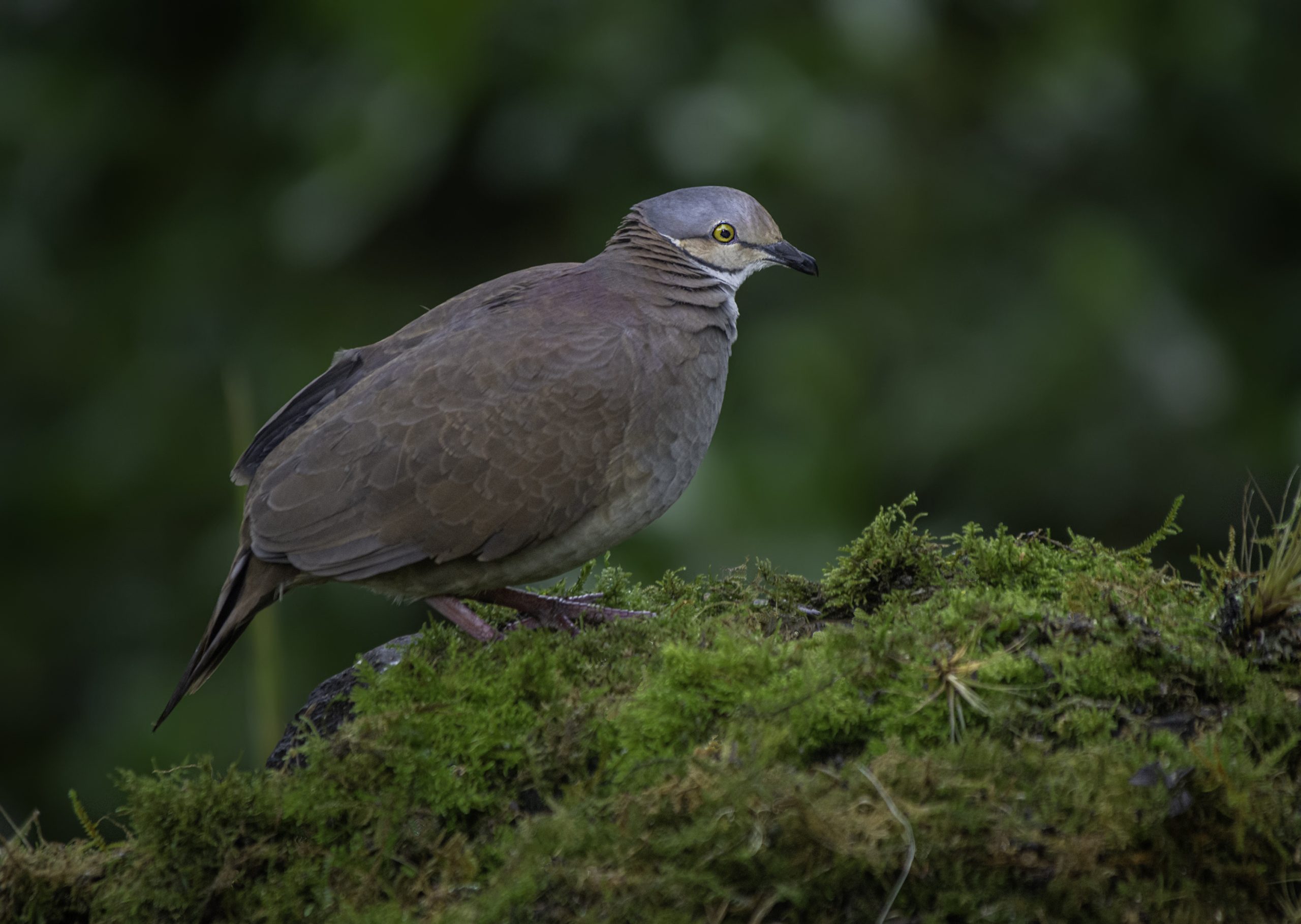Order: COLUMBIFORMES
Family: COLUMBIDAE
Previously classified in the genus Geotrygon, four races have traditionally been recognized although their current status remains doubtful. Its name Zentrygon derives from the genus Zenaida, which in turn, was established in honor of Zénaïde Laetitia Julie Princesse Bonaparte wife of the French Ornithologist Prince Bonaparte and from the Greek root treron = dove. The epithet frenata comes from the Latin frenatus = flanged.
Description
It measures 30 to 34 cm and weighs around 311 g. It has a buff colored forehead and region under the eye, bordered below by a long and narrow black mustache. Its crown is blue-gray in color and the rest of the upper parts are dark reddish brown with a purple luster on the upper back. It has a white throat and front part of the neck, a brownish-gray chest that turns brown in the lower parts, except for the abdomen that is whitish. The female is less gray than the male and the young individual has tawny barred and fuscous on the lower and upper parts.
Similar species
It could be confused with the Lined Quail-Dove (Zentrygon linearis) which is smaller, with a cinnamon crown, not bluish-gray, buffy breast and tawny belly, not gray and whitish respectively. The Russet-crowned Quail-Dove (Zentrygon goldmani) is also very similar but with a mainly cinnamon head, not bluish gray.
Regional Differences
Four subspecies are tentatively recognized: Z. l. bourcieri, Z. l. erythropareia, Z. l. frenata and Z. l. margaritae of which only the bourcieri breed is found in Colombia.
Distribution
It is found in the Andes of central and western Colombia to the south through Ecuador, Peru, Bolivia and northwestern Argentina. In Colombia it is distributed mainly from 1500 to 2500 m above sea level on the western slope of the Western Cordillera from the headwaters of the Tatamá River to the south and on the eastern slope above Cali. On occasions it has been recorded at an altitude of 900 m in the valley of the Anchicayá river. It is also found on both slopes of the Central mountain range from Quindío south to the headwaters of the Magdalena valley and both slopes in Nariño.
Habitat
It lives in humid and very humid montane forests and in secondary mountains.
Feeding
Unknown It is presumed that, like other species of the family, it feeds on seeds, fruits and insects.
Reproduction
In Colombia, individuals in reproductive condition have been recorded in August in the Munchique National Natural Park in the department of Cauca, from January to July in the Western Cordillera, and a nest in March. Its nest is a platform, which it builds 2 m high on a tangle. A pale buff colored egg was found in the recorded nest.
Behaviour.
It remains alone, in pairs and sometimes in groups of three individuals. It feeds on the ground and if disturbed it hides in the foliage or silently glides along the ground.
Taxonomy
Formerly classified in the genera Oreopeleia and Geotrygon. The bourcieri and erythropareia races have come to be considered distinct species. However, the taxon erythropareia could simply be a dark morph.
Conservation Status
At the national and international level, it is classified as a species of least concern.
Vocalization/ Voice
https://www.xeno-canto.org/605938
References
Banks, R.C., J. D. Weckstein, J.V. Remsen, JR. & K. P. Johnson. 2013. Classification of a clade of New World doves (Columbidae: Zenaidini). Zootaxa (2): 184–188.
BirdLife International (2017) Species factsheet: Zentrygon frenata. Downloaded from http://www.birdlife.org on 08/31/2017.
Avibase (2017). Species factsheet: Zentrygon frenata. Downloaded from https://avibase.bsc-eoc.org/species.jsp? Lang = ES & avibaseid = ADE69C27FF73AD79 on 08/01/2017.
Baptista, L. F., P. W. Trail & H. M. Horblit. Zentrygon brakes. Pp 173-174 In: Del-Hoyo, J., Elliot, A. and Sargatal, J. 1997. Handbook of the Birds of the Wold. Vol 4. Sandgrouse to Cuckoos. Lynx editions. Barcelona. 679p.
Jobling, C. 2010. The Helm dictionary of scientific birds names. Christopher Helm and A & C Black Publishers Ltda. London. 433p.
Hilty, S. L. and W. L. Brown. 2001. Guide to the Birds of Colombia. Princetn. Univ. Press, Princeton, NJ
The IUCN Red List of Threatened Species. Version 2017-1. <www.iucnredlist.org>. Downloaded on 03 August 2017.









